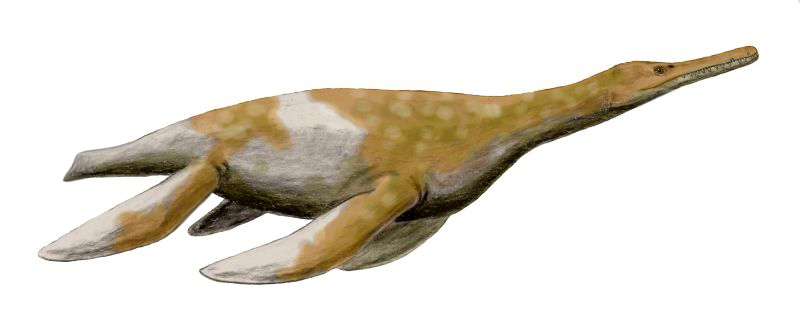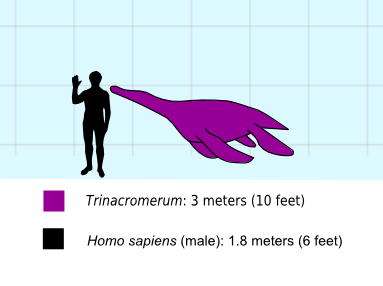|
Scalamagnus Tropicensis
''Scalamagnus'' is an extinct genus of polycotylid plesiosaur from the Late Cretaceous Tropic Shale Formation of the United States. The genus contains a Monotypic taxon, single species ''S. tropicensis'', known from a skull and two partial skeletons. ''Scalamagnus'' was historically considered to represent a species of the genus ''Dolichorhynchops'' before it was moved to its own genus. History The taxon was first named as a species of ''Dolichorhynchops'' by Rebecca Schmeisser McKean in 2012 in paleontology, 2012. The specific name (zoology), specific name is derived from the name of the Tropic Shale, in which the two specimens were found. It is known from the holotype Museum of Northern Arizona, MNA V10046, an almost complete, well-preserved long skeleton including most of the skull and from the referred specimen MNA V9431, fragmentary postcranial elements. It was collected between 2003 and 2005 by the Museum of Northern Arizona from a single locality within the Tropi ... [...More Info...] [...Related Items...] OR: [Wikipedia] [Google] [Baidu] |
Late Cretaceous
The Late Cretaceous (100.5–66 Ma) is the more recent of two epochs into which the Cretaceous Period is divided in the geologic time scale. Rock strata from this epoch form the Upper Cretaceous Series. The Cretaceous is named after ''creta'', the Latin word for the white limestone known as chalk. The chalk of northern France and the white cliffs of south-eastern England date from the Cretaceous Period. Climate During the Late Cretaceous, the climate was warmer than present, although throughout the period a cooling trend is evident. The tropics became restricted to equatorial regions and northern latitudes experienced markedly more seasonal climatic conditions. Geography Due to plate tectonics, the Americas were gradually moving westward, causing the Atlantic Ocean to expand. The Western Interior Seaway divided North America into eastern and western halves; Appalachia and Laramidia. India maintained a northward course towards Asia. In the Southern Hemisphere, Aus ... [...More Info...] [...Related Items...] OR: [Wikipedia] [Google] [Baidu] |
Utah
Utah is a landlocked state in the Mountain states, Mountain West subregion of the Western United States. It is one of the Four Corners states, sharing a border with Arizona, Colorado, and New Mexico. It also borders Wyoming to the northeast, Idaho to the north, and Nevada to the west. In comparison to all the U.S. states and territories, Utah, with a population of just over three million, is the List of U.S. states and territories by area, 13th largest by area, the List of U.S. states and territories by population, 30th most populous, and the List of U.S. states by population density, 11th least densely populated. Urban development is mostly concentrated in two regions: the Wasatch Front in the north-central part of the state, which includes the state capital, Salt Lake City, and is home to roughly two-thirds of the population; and Washington County, Utah, Washington County in the southwest, which has approximately 180,000 residents. Most of the western half of Utah lies in ... [...More Info...] [...Related Items...] OR: [Wikipedia] [Google] [Baidu] |
Cladogram
A cladogram (from Greek language, Greek ''clados'' "branch" and ''gramma'' "character") is a diagram used in cladistics to show relations among organisms. A cladogram is not, however, an Phylogenetic tree, evolutionary tree because it does not show how ancestors are related to descendants, nor does it show how much they have changed, so many differing evolutionary trees can be consistent with the same cladogram. A cladogram uses lines that branch off in different directions ending at a clade, a group of organisms with a last common ancestor. There are many shapes of cladograms but they all have lines that branch off from other lines. The lines can be traced back to where they branch off. These branching off points represent a hypothetical ancestor (not an actual entity) which can be inferred to exhibit the traits shared among the terminal taxa above it. This hypothetical ancestor might then provide clues about the order of evolution of various features, adaptation, and other e ... [...More Info...] [...Related Items...] OR: [Wikipedia] [Google] [Baidu] |
Phylogenetic Analyses
In biology, phylogenetics () is the study of the evolutionary history of life using observable characteristics of organisms (or genes), which is known as Computational phylogenetics, phylogenetic inference. It infers the relationship among organisms based on empirical data and observed heritable traits of DNA sequences, protein amino acid sequences, and Morphology (biology), morphology. The results are a phylogenetic tree—a diagram depicting the hypothesis, hypothetical relationships among the organisms, reflecting their inferred evolutionary history. The tips of a phylogenetic tree represent the observed entities, which can be living Taxon, taxa or fossils. A phylogenetic diagram can be rooted or unrooted. A rooted tree diagram indicates the hypothetical common ancestor of the taxa represented on the tree. An unrooted tree diagram (a network) makes no assumption about directionality of character state transformation, and does not show the origin or "root" of the taxa in questi ... [...More Info...] [...Related Items...] OR: [Wikipedia] [Google] [Baidu] |
Polycotylinae
Polycotylidae is a family of plesiosaurs from the Cretaceous, a sister group to Leptocleididae. They are known as false pliosaurs. Polycotylids first appeared during the Albian stage of the Early Cretaceous, before becoming abundant and widespread during the early Late Cretaceous. Several species survived into the final stage of the Cretaceous, the early Maastrichtian around . The possible latest surviving member ''Rarosaurus'' from the late Maastrichtian is more likely a crocodylomorph. With their short necks and large elongated heads, they resemble the pliosaurs, but closer phylogenetic studies indicate that they share many common features with the Leptocleididae and Elasmosauridae. They have been found worldwide, with specimens reported from New Zealand, Australia, Japan, Morocco, the US, Canada, Eastern Europe, and South America. Phylogeny Cladogram A cladogram (from Greek language, Greek ''clados'' "branch" and ''gramma'' "character") is a diagram used in cladistics ... [...More Info...] [...Related Items...] OR: [Wikipedia] [Google] [Baidu] |
Sister Taxon
In phylogenetics, a sister group or sister taxon, also called an adelphotaxon, comprises the closest relative(s) of another given unit in an evolutionary tree. Definition The expression is most easily illustrated by a cladogram: Taxon A and taxon B are sister groups to each other. Taxa A and B, together with any other extant or extinct descendants of their most recent common ancestor (MRCA), form a monophyletic group, the clade AB. Clade AB and taxon C are also sister groups. Taxa A, B, and C, together with all other descendants of their MRCA form the clade ABC. The whole clade ABC is itself a subtree of a larger tree which offers yet more sister group relationships, both among the leaves and among larger, more deeply rooted clades. The tree structure shown connects through its root to the rest of the universal tree of life. In cladistic standards, taxa A, B, and C may represent specimens, species, genera, or any other taxonomic units. If A and B are at the same taxonomic ... [...More Info...] [...Related Items...] OR: [Wikipedia] [Google] [Baidu] |
Leptocleidia
Plesiosauroidea (; Greek: 'near, close to' and 'lizard') is an extinct clade of carnivorous marine reptiles. They have the snake-like longest neck to body ratio of any reptile. Plesiosauroids are known from the Jurassic and Cretaceous periods. After their discovery, some plesiosauroids were said to have resembled "a snake threaded through the shell of a turtle", although they had no shell. Plesiosauroidea appeared at the Early Jurassic Period (late Sinemurian stage) and thrived until the K-Pg extinction, at the end of the Cretaceous Period. The oldest confirmed plesiosauroid is ''Plesiosaurus'' itself, as all younger taxa were recently found to be pliosauroids. While they were Mesozoic diapsid reptiles that lived at the same time as dinosaurs, they did not belong to the latter. Gastroliths are frequently found associated with plesiosaurs. History of discovery The first complete plesiosauroid skeletons were found in England by Mary Anning, in the early 19th century, and w ... [...More Info...] [...Related Items...] OR: [Wikipedia] [Google] [Baidu] |
Grand Staircase-Escalante National Monument
Grand may refer to: People with the name * Grand (surname) * Grand L. Bush (born 1955), American actor Places * Grand, Oklahoma, USA * Grand, Vosges, village and commune in France with Gallo-Roman amphitheatre * Grand County (other), several places * Grand Geyser, Upper Geyser Basin of Yellowstone, USA * Le Grand, California, USA; census-designated place * Mount Grand, Brockville, New Zealand Arts, entertainment, and media * ''Grand'' (Erin McKeown album), 2003 * "Grand" (Kane Brown song), 2022 * ''Grand'' (Matt and Kim album), 2009 * ''Grand'' (magazine), a lifestyle magazine related to related to grandparents * ''Grand'' (TV series), American sitcom, 1990 * Grand Production, Serbian record label company Other uses * Great Recycling and Northern Development Canal, also known as GRAND Canal * Grand (slang), one thousand units of currency * Giant Radio Array for Neutrino Detection, also known as GRAND See also * * * Grand Hotel (other) * Grand st ... [...More Info...] [...Related Items...] OR: [Wikipedia] [Google] [Baidu] |
Latin
Latin ( or ) is a classical language belonging to the Italic languages, Italic branch of the Indo-European languages. Latin was originally spoken by the Latins (Italic tribe), Latins in Latium (now known as Lazio), the lower Tiber area around Rome, Italy. Through the expansion of the Roman Republic, it became the dominant language in the Italian Peninsula and subsequently throughout the Roman Empire. It has greatly influenced many languages, Latin influence in English, including English, having contributed List of Latin words with English derivatives, many words to the English lexicon, particularly after the Christianity in Anglo-Saxon England, Christianization of the Anglo-Saxons and the Norman Conquest. Latin Root (linguistics), roots appear frequently in the technical vocabulary used by fields such as theology, List of Latin and Greek words commonly used in systematic names, the sciences, List of medical roots, suffixes and prefixes, medicine, and List of Latin legal terms ... [...More Info...] [...Related Items...] OR: [Wikipedia] [Google] [Baidu] |
Endemism
Endemism is the state of a species being found only in a single defined geographic location, such as an island, state, nation, country or other defined zone; organisms that are indigenous to a place are not endemic to it if they are also found elsewhere. For example, the Cape sugarbird is found exclusively in southwestern South Africa and is therefore said to be ''endemic'' to that particular part of the world. An endemic species can also be referred to as an ''endemism'' or, in scientific literature, as an ''endemite''. Similarly, many species found in the Western ghats of India are examples of endemism. Endemism is an important concept in conservation biology for measuring biodiversity in a particular place and evaluating the risk of extinction for species. Endemism is also of interest in evolutionary biology, because it provides clues about how changes in the environment cause species to undergo range shifts (potentially expanding their range into a larger area or b ... [...More Info...] [...Related Items...] OR: [Wikipedia] [Google] [Baidu] |
Trinacromerum
''Trinacromerum'' is an extinct genus of sauropterygian reptile, a member of the polycotylid plesiosaurs. It contains two species, ''T. bentonianum'' and ''T. kirki''. Specimens have been discovered in the Late Cretaceous fossil deposits of what is now modern Kansas and Manitoba. Some fossils are also found in the Southern United States such as in the Mooreville Chalk of Alabama. Description ''Trinacromerum'' was long. Its teeth show that it fed on small fish. The long flippers of ''Trinacromerum'' enabled it to achieve high swimming speeds. Its physical appearance was described by Richard Ellis as akin to a "four-flippered penguin."Ellis, 190 Its name means "three tipped femur". Classification Below is a cladogram of polycotylid relationships from Ketchum & Benson, 2011. See also * List of plesiosaur genera * Timeline of plesiosaur research This timeline of plesiosaur research is a chronologically ordered list of important fossil discoveries, controversies of interpr ... [...More Info...] [...Related Items...] OR: [Wikipedia] [Google] [Baidu] |








